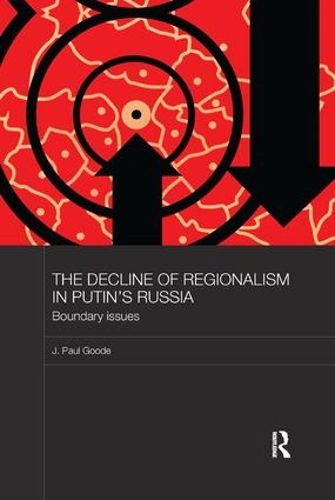Readings Newsletter
Become a Readings Member to make your shopping experience even easier.
Sign in or sign up for free!
You’re not far away from qualifying for FREE standard shipping within Australia
You’ve qualified for FREE standard shipping within Australia
The cart is loading…






This book reassesses Putin’s attempt to reverse the decentralization of power that characterised centre-regional relations in the 1990s, focusing on regional responses to Putin’s federal reforms. It explains the decline of regionalism after 2000 in terms of the dynamics of regional boundaries, understood as the juridical boundaries which demarcate a region’s territorial extent and its resources; institutional boundaries that sustain regional differences; and cultural boundaries that define the ethnic or technocratic principles on which a region could claim legitimate existence.
The book questions the conventional wisdom regarding the success of Putin’s regime. It shows how regional governors responded not by attempting to deflect the reforms with outright resistance, but by mimicking Putin’s centralisation of power at the regional level. In turn, this facilitated the homogenisation of regional political regimes and regional mergers. The book demonstrates how the reordering of regions advanced sporadically, how pockets of resistance persist, and how the potential for the revival of regionalism continues.
$9.00 standard shipping within Australia
FREE standard shipping within Australia for orders over $100.00
Express & International shipping calculated at checkout
This book reassesses Putin’s attempt to reverse the decentralization of power that characterised centre-regional relations in the 1990s, focusing on regional responses to Putin’s federal reforms. It explains the decline of regionalism after 2000 in terms of the dynamics of regional boundaries, understood as the juridical boundaries which demarcate a region’s territorial extent and its resources; institutional boundaries that sustain regional differences; and cultural boundaries that define the ethnic or technocratic principles on which a region could claim legitimate existence.
The book questions the conventional wisdom regarding the success of Putin’s regime. It shows how regional governors responded not by attempting to deflect the reforms with outright resistance, but by mimicking Putin’s centralisation of power at the regional level. In turn, this facilitated the homogenisation of regional political regimes and regional mergers. The book demonstrates how the reordering of regions advanced sporadically, how pockets of resistance persist, and how the potential for the revival of regionalism continues.